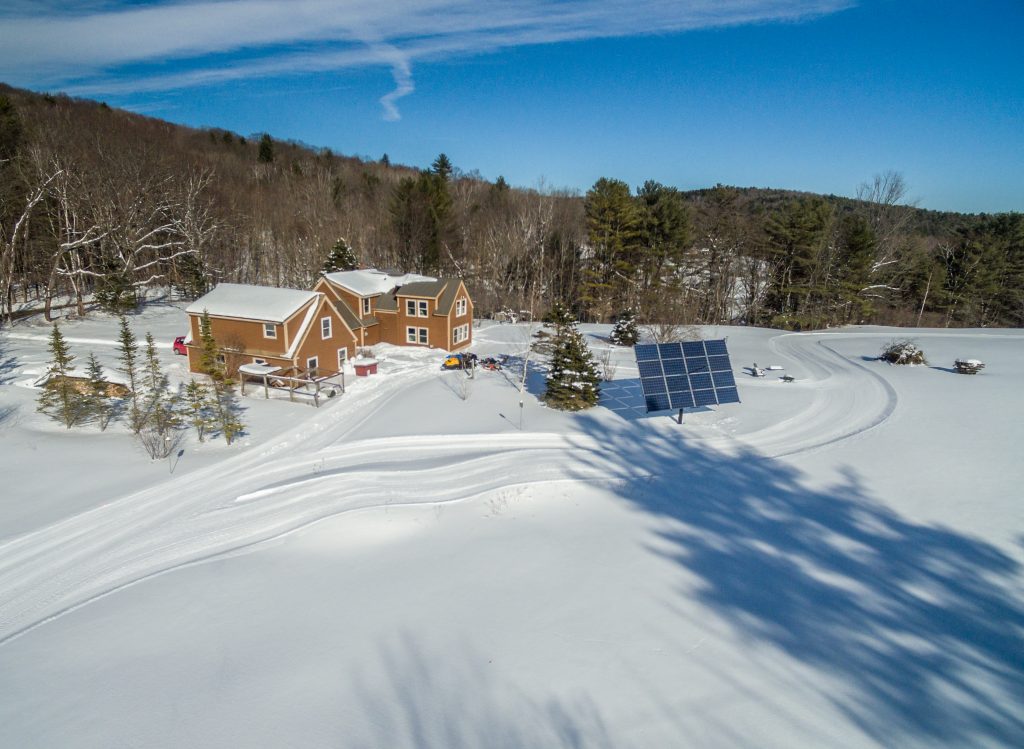
Winters in New England may be steadily warming due to climate change, but reliable home heating is still a must. This doesn’t mean you have to burn fossil fuels to keep your home warm, though. Electric heat pumps, running on solar power, can keep your house toasty warm even on the coldest winter days. And with more summer heat waves in the offing, heat pumps can efficiently cool your home as well.
So what is this device that can magically pull heat from the air, ground or water, even at temperatures below freezing. How do they work? Should I get one for my home? We’ve got answers for you.
“What is a heat pump? How do they work?”
A heat pump operates on the same engineering principle as a home refrigerator or air conditioner. It extracts energy from ambient heat outside your home, concentrates it with the aid of a refrigerant in a heat-exchanging coil, and delivers it as processed heat or cooling inside your home. Most heat pumps in our area are air-sourced, but ground-source heat pumps also are an option for those with enough outdoor space (and money!) to lay out an underground piping system. For a more technical description, check out this video
“What makes heat pumps so special?”
Heat pumps offer two main advantages. First, they are highly energy efficient. With an energy coefficient of performance (COP) of 3, they are capable of producing three kilowatts of thermal energy for every kilowatt of electricity they consume. (Even the most efficient electric baseboard heaters and gas-fired boilers have a COP of 1 or less.) Second, they can run on clean solar power, replacing carbon-based sources like heating oil, wood or propane. Considering that residential and commercial space heating accounts for 11% of global warming emissions, heat pumps powered by solar can make a real dent in shrinking your carbon footprint.
“Is it cost-effective to run a heat pump with a Solaflect Tracker?”
As a rule of thumb, you can power a 10,000 Btu heat pump with about 2,400 kWh of electricity annually. That works out to about one-third of the annual electricity production of a Solaflect Tracker. A residential heat pump typically costs $4,000 – $8,000 to purchase and install. (Your costs will vary depending on the size of your home, the type of unit selected, and the availability of rebates and other financing incentives). Payback times will be based mainly on avoided utility bills – more than $500 a month for some whole-house heat pumps — and the possible avoided costs of going without a home furnace.
“Can heat pumps really handle New England winters?”
In short, yes. At outdoor temperatures of 5°F, cold-climate heat pumps continue to function at 100% heating capacity. Even at -13°F, they can maintain up to 76% capacity. For the coldest winter nights, room space heaters or wood stoves can serve as a back-up source of heat.
“How do I get the best value out of my heat pump?”
First, do your homework! Correct sizing for your home is critical. If you live in a cold pocket, you may want to over-estimate your HVAC needs somewhat to compensate for any efficiency losses. Second, consider the condition of insulation in your home. No matter how you heat your home, properly fitted insulation is the best and cheapest way to save on energy and keep your heat pump running optimally.
Heat Pump Reflections from a Solaflect Customer
John Sherman was tired of purchasing up to 1,000 gallons of heating oil for his home in Lebanon every year. He wanted to cut down on his oil bill and carbon footprint, and had prior work experience installing heat pumps. So he put together a plan to outfit his own home with heat pumps that would run on solar power eventually.
John purchased two Mitsubishi air-based heat pumps in December 2018, one for each floor of his house. Once up and running, he monitored their electricity use for six months to spec out future demand on a solar array. He also decided to keep his furnace as a back-up for cold winter months. Now he’s burning less than 250 gallons a year, and he says the heat pumps are throwing out “great heat” even on cold winter days. And he’s loving the air conditioning that the heat pumps provide during hot summer weather. To maximize the year-round benefits, John also added more insulation to his home’s attic and walls.
Before investing in these home improvements, John was paying $100-$150 per month for electricity, and even more for home heating oil. In the first six months of operation, as John backed off of oil, his heat pumps caused his electricity bill to surge to $600 per month. But once he added two Solaflect Trackers in June 2019, the operating cost for his heat pumps dropped to zero, and he hasn’t paid an electric bill since. John has even amassed a $700 utility credit for the solar power he’s been selling back into the grid. And his oil company has been calling to see if something’s wrong with his furnace now that his oil bill has fallen by 75%!
John’s one complaint is that he didn’t like the remote control that came with his manufacturer’s heat pump. He wanted more temperature control options and easier ways to download energy performance data. But with home energy management going digital, he had lots of options to find an affordable smart controller that integrates easily with his home energy installation.
Solafect Energy helps you make complex home energy decisions simple. Our Solar Trackers are fully integrated to run all your home electricity needs including home heat pumps and will also charge your electric vehicles.
And we love talking about all things related to solar, so please reach out to us or call us at (802) 649-3700 if we can answer questions and help you think about how solar can cover an ever-increasing share of your family’s power usage!



